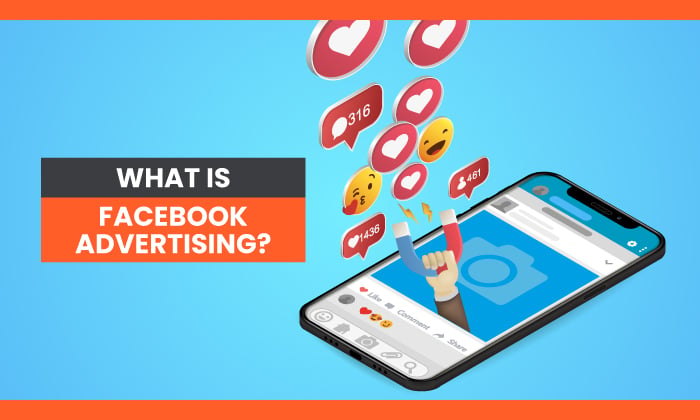
Everybody knows about Facebook, but do they know how to make the most of Facebook advertising?
We’re so used to scrolling through Facebook and seeing ads that we almost don’t notice them, and for marketers, this is a powerful tool. How can you put Facebook ads to good use for your business and see that all-important return on investment?
Why Should You Advertise on Facebook?
It’s hard to look past Facebook’s reach. With nearly 3 billion active users, that’s a whole lot of people seeing Facebook ads on a regular basis.
We’re always talking about being targeted with your marketing though, so reach is just one part of the equation. Successful marketing doesn’t reach everyone, it reaches the right people, and this is where Facebook is incredibly useful.
When it comes to detailed targeting, Facebook is almost unparalleled. It knows so much about its users, and this information helps advertisers reach the right people with the right message.
This ability to accurately target specific groups of people draws in nearly 10 million active advertisers and earns Facebook $28.6 billion per quarter.
You can’t argue with the results which means you can’t deny the power of Facebook ads.
They’re super profitable. (If, and that’s a big IF, you know what you’re doing.)
Who Should Advertise on Facebook?
A key thing to remember with Facebook advertising is the people you reach aren’t actively looking to buy your product or service. They’re relaxing, engaging with friends, looking for funny videos, etc., and you’ve interrupted that with your advert.
It’s not often you make a sale with a single touchpoint, but it’s even less likely with Facebook ads because people aren’t actively looking for your products. Businesses that get into Facebook ads expecting a quick sale often end up disappointed.
Many businesses fail at Facebook advertising because they are not a good fit. You should always test new marketing channels, especially before demand drives up prices, but make sure to consider whether your business model is a good fit for Facebook.
Here are a few types of businesses that are likely to succeed with Facebook advertising.
Businesses With Low-Friction Conversions
The businesses that succeed with Facebook ads ask users to sign up, not to buy. You must use a low-friction conversion to be successful.
A visitor to your website wasn’t looking for your product. They clicked your ad on a whim. If you’re relying on them to immediately buy something to make your ad ROI positive, you will fail.
Facebook users are fickle and likely to click back to Facebook if you ask for a big commitment (purchase) upfront. Instead, stick to simple conversions like signing up for your service, filling out a short lead form, or submitting an email address.
Even if you sell products, not services, you should consider focusing on an intermediate conversion like a newsletter signup. Then you can upsell later through email marketing or Facebook retargeting ads.
Daily deal sites like Groupon, AppSumo, and Fab are good examples of businesses that can succeed with Facebook advertising. After you click one of their ads, they just ask for your email address. They’ll sell you on a deal later.
Business Model With Long Sales Cycle or Small Purchases
Even if you only ask for an email address initially, you’ll need to eventually make money from these users if your ads are to be profitable.
The best business model that fits Facebook ads earns revenue from their users over time, not all at once. A user may have given you their email, but you’ll need to build more trust before they are likely to buy anything.
You shouldn’t depend on one big purchase. Several smaller purchases are ideal.
Daily deals and subscription sites are great examples of business models that can thrive on Facebook. Both have customers whose lifetime value is spread out over six months or more.
At Udemy, they focus on getting users to sign up on their first visit. By aiming to be profitable on ad spend in six months (not one day), they turn Facebook users into long-term customers.
They target a 20 percent payback on ad spend on day one and 100 percent payback in six months. These numbers can serve as a rough guide for your business.
How Do Facebook Ads Work?
Facebook ads now come in several varieties. You can promote your Page, posts on your Page, actions users took, or your website itself. Despite Facebook’s increasing focus on native ads and keeping traffic on its site, you can still be successful in sending users to your website.
There are also several ad formats including images, videos, carousel (multiple images), Instant Experiences, and collections.
Facebook ads are targeted to users based on their location, demographic, and profile information. Many of these options are only available on Facebook.
After creating an ad, you set a budget and bid for each click or thousand impressions that your ad will receive.
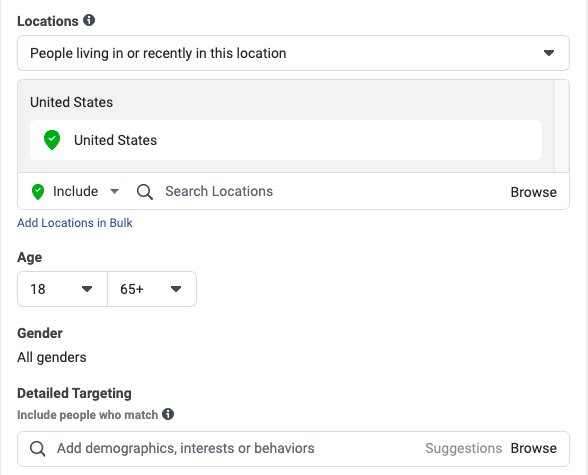
Users then see your ads in the sidebar on Facebook or in their newsfeed.
As marketers, our main goal is generally to drive traffic to our own websites. Building your Facebook presence is great, but when you bring someone to your website, you control the medium, and this gives you the best chance of converting on your goals.
Facebook’s other ad options are great for driving engagement and brand awareness, but ads driving users off-site are still the best option for direct response advertisers looking to make a sale.
9 Top Tips for Creating Facebook Ads
Facebook advertising has great potential but it isn’t as easy as just creating a bit of copy and watching the sales come in. Getting Facebook Ads right takes a considered approach and lots of optimization until you find the perfect strategy.
Here are nine top tips to help you optimize your Facebook ad campaigns.
1. Target Your Facebook Ads
At the beginning of this article, we asked: why advertise on Facebook? The two main reasons were reach and Facebook’s almost unparalleled targeting.
The problem is, lots of businesses don’t take advantage of the targeting that’s available to them. They go for a bigger is better approach, when in reality, what matters is getting your products or services in front of the people who need them the most.
The number one mistake most marketers make with Facebook ads is not targeting them correctly.
Facebook’s ad targeting options are unparalleled. You can target by demographics and create custom or lookalike audiences to target users similar to your best customers. You can also use retargeting ads to target users who interacted with your page or visited your website.
On Facebook, you can directly target users by:
- location
- age
- gender
- interests
- connections
- relationship status
- languages
- education
- workplaces
Each option can be useful, depending on your audience. Most marketers should focus on location, age, gender, and interests.
- Location allows you to target users in the country, state, city, or zip code that you service.
- Age and gender targeting should be based on your existing customers. If women 25-44 are the bulk of your customers, start out targeting them. If they prove to be profitable, you can then expand your targeting.
- Interest targeting is the most powerful but misused feature of Facebook ads. When creating an ad, you have two options: broad categories or detailed interests.
Broad Category Targeting
Broad categories include topics like Gardening, Horror Movies, and Consumer Electronics. Recently, Facebook has added newer targets like Engaged (1 year), Expecting Parents, Away from Hometown, and Has Birthday in 1 Week.
Broad interests may seem like an efficient way to reach a large audience. However, these users often cost more and spend less. You’ll also need to install the Facebook pixel.
This used to be an ineffective way to reach audiences; however, the addition of the Facebook pixel and dynamic ads makes this far more effective.
It is worth testing, but detailed interest targeting is often more effective.
Detailed Interest Targeting
Detailed Interest targeting allows you to target users based on information in their profile including “listed likes and interests, the Pages they like, apps they use, and other profile (timeline) content they’ve provided” (according to Facebook).
You’ll find the best ROI using Detailed Interest targeting.
Facebook has an amazing array of interests to target from Harry Potter to underwater rugby. The hard part is choosing the right ones.
When targeting detailed interests, Facebook provides the size of the audience and other suggested likes and interests. You won’t have any competitive data, but once you select interests for an ad, Facebook will show an aggregate suggested bid.
Many marketers target the largest groups possible. This is a mistake as these groups are more expensive and less targeted.
Rather than target broad terms for your niche like “yoga” or “digital photography,” focus on specific interests. Research which magazines and blogs your customers read, who they follow on Twitter, and which related products they buy.
If you use laser-focused interests like these, you’ll reach the people who are most interested in your topic and the most willing to spend money on it.
For example, if you wanted to sell a new DJ course, don’t just target the interest of “disc jockey.”
Instead, create ads targeting DJ publications like DJ Magazine and Mixmag. Then create another ad targeting DJ brands like Traktor and Vestax.
Combine smaller, related interests into a group with an audience of 50,000 to 1M+. This structure will create ads with large audiences that are likely to convert.
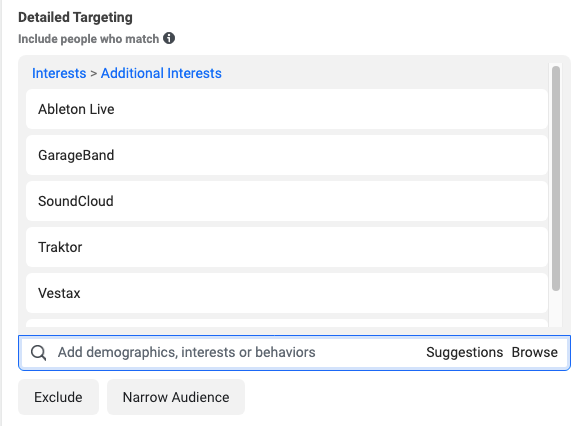
Advanced tip: Use Facebook Login as a sign-up option on your site. When users connect via Facebook, you’ll be able to analyze their interests. Index these interests against the number of fans of their respective Facebook Pages. You’ll be left with your high-affinity interests.
Facebook Lookalike Audiences
In addition to targeting users directly, Facebook gives you the ability to create Lookalike Audiences.
These are Facebook users that are similar to your current users. You’ll need to have Facebook Pixel or other custom audience data, like an email list. Then, you can ask Facebook to find similar users.
They are highly customizable, for example, you could create a “new customer” ad, then exclude current customers from seeing your ads.
This page on Facebook will walk you through how to create Lookalike audiences.
Retargeting With Facebook Ads
Retargeting ads allow you to reach customers who are already familiar with your brand. You can double down by creating dynamic ads that show people items they are likely to be interested in.
For example, you could retarget users who have visited your site, left items in their cart, or clicked on an ad.
To create a retargeting ad, the first step is to install the Facebook Pixel. Check out my guide on how to do remarketing, and make sure you’re creating multiple touch points with potential customers.
2. Include Images
Facebook is a visual place. How often do you stop to read a post that’s made up completely of text versus one that contains video or images?
The most important part of your Facebook ad is the image. You can write the most brilliant copy in the world, but if your image doesn’t catch a user’s eye, you won’t get any clicks.
Don’t use low-quality images, generic stock photography, or any images that you don’t have the rights to use. Don’t steal anything from Google Images. Unless you’re a famous brand, don’t use your logo.
Now that we have the no’s out of the way, how should advertisers find images to use? Buy them, create them yourself, or use ones with a Creative Commons license.
Here are some ways to make your images stand out on the platform:
- People: Images of people work best, preferably their faces. Use close-ups of attractive faces that resemble your target audience.
- Typography: Clear, readable type can also attract clicks. Bright colors will help your ad stand out.
- Funny: Crazy or funny pictures definitely attract clicks. Unfortunately, even with descriptive ad text, these ads don’t always convert well. If you use this type of ad, set a low budget and track the performance closely.
- Rotate ads: Each campaign should have at least three ads with the same interest targets. Using a small number of ads will allow you to gather data on each one. Delete the ads with the lowest CTR and create new versions of the ones with the best CTRs.
The average CTR for Facebook advertising across all industries is 0.89 percent, so keep working on your images to take you past this number.
3. Write Great Copy
After seeing your image, users will (hopefully) read your ad text. Here you can sell them on your product or service and earn their click. Despite the 40 character headline and 125 character body text limits, we can still use the famous copywriting formula AIDA.
- (A)ttention: Draw users into the ad with an attention-grabbing headline.
- (I)nterest: Get the user interested in your product by briefly describing the most important benefit of using it.
- (D)esire: Create an immediate desire for your product with a discount, free trial, or limited-time offer.
- (A)ction: End the ad with a call to action.
AIDA is a lot to fit into 165 characters so write five or ten ads until you’re able to fit a succinct sales pitch into the ad.
Here’s an example for an online programming course:
Become a Web Developer
Learn everything you need to become a web developer from scratch.
Save 65%. Enroll now!
Use your different ad sets to experiment with your copy and find the best approach. It might be your image that grabs people’s attention, but your copy is vital to getting them to take action.
4. Follow Best Practices for Bidding on Facebook Ads
Like on any ad network, strategic bidding can mean the difference between profit and a failed campaign.
After you create your ad, Facebook will provide a suggested bid range. When you’re just starting out, set your bid near the low end of this range. Your CTR will quickly start to dictate the price you’ll need to pay for traffic.
If your CTR is high, your suggested bids will decrease. If your CTR is low, you’ll need to bid more for each click. Optimize your ads and targets to continually increase your CTR.
In addition to click volume, your bid will also dictate how much of your target audience you’re able to reach. Facebook provides a great chart for every campaign showing the size of your target audience and how much of that audience you’ve reached.
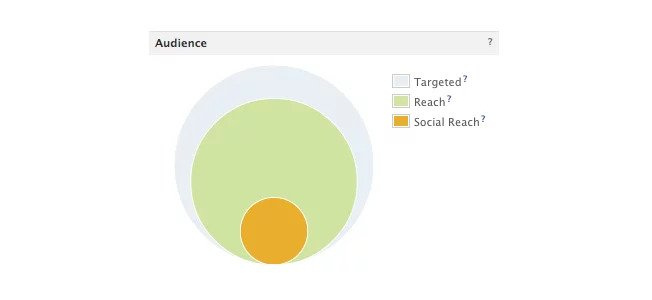
Increasing your bid will help your ad reach more of your target audience. If your ad is performing well but you’re reaching less than 75 percent of your target audience, you can increase your bid to get more clicks.
If your audience penetration is high, increasing your budget will increase your ad’s frequency: how many times a targeted user will see it.
5. Create a Landing Page for Your Facebook Ad
Getting people to click your Facebook ad is only half of the puzzle. Ultimately, your ROI will be based on the actions people take once they reach your landing page.
Getting a click is only the beginning. You still need the visitor to convert.
Make sure to send people to a targeted, high-converting landing page. You know their age, gender, and interests, so show them a page that will solve their problems.
The landing page should also contain the registration form or email submit box that you’ll track as a conversion. Keep your landing pages simple. Don’t bombard people with different options; give them the information they need to make an informed decision, but focus on getting them to take one single option.
If you want visitors to sign up for your newsletter, show them the benefits or offer a free gift for their email.
6. Track Your Facebook Ad’s Performance
Facebook Ads Manager provides a huge amount of data on how people interact with your ads. However, once people click to your website, it doesn’t offer the same level of insights, so you’ve got to use an analytics program like Google Analytics.
By tagging your links using Google’s URL builder or your own tracking tags, you can easily keep track of how traffic from your Facebook ads interacts with your site. This will allow you to see how effective your ads are based on aspects like lead generation, number of sales, and total revenue.
Conversion Tracking
As mentioned above, make sure to separate campaigns by interest groups so that you can see how each one performs. You can track them using Google Tags using the utm_content parameter to differentiate between the different ad sets.
Ad-level tracking is useful when testing eye-catching images and before you’ve established a baseline CTR and conversion rate.
Performance Tracking
You will also need to monitor your performance within the Facebook interface. The most important metric to track is the click-through rate. Your CTR affects both the number of clicks you’ll receive and the amount you will pay per click.
Ads with a low CTR will stop serving or become more expensive. Ads with a high CTR will generate as many clicks as will fit within your budget. They will also cost less. Keep a close eye on CTR by interests and ads to learn which audiences work best and which ads resonate with them.
Keep in mind: even the best ad’s performance will decline over time. The smaller your target audience is, the faster this will happen. Usually, you’ll see your traffic start to drop off in 3-10 days.
When this happens, refresh the ads with new images and copy. Duplicate your existing ads then change the image and ad text. Do not edit the existing ad. Delete any existing ads not getting clicks. By the next day, you’ll see the new ads accruing impressions and clicks.
Monitor the images’ performance over time to see which ones generate the best CTR and maintain their traffic the longest. You can rotate high-performing images back every few weeks until they stop getting clicked on at all.
7. Create a Realistic FB Advertising Budget
We’ve talked about creating multiple ads that use different images and target specific interests, so how do you go about creating a realistic Facebook advertising budget for this?
It comes down to a simple equation: how many impressions do you need to make “x” number of sales to earn “y” revenue?
Start with a few simple questions:
- How much is your product or service?
- How many do you want to sell?
- What’s your conversion rate already?
Let’s say your answers look like this:
- Product value: $100
- You want to sell: 10
- Conversion rate: 1 percent
If we want to make $10,000 in revenue, then we have to sell 1,000 units. At a 1 percent conversion rate, that means we need 100,000 impressions. Now, take your average CPC and times it by 100,000, and you have a rough idea of what your budget should be.
Break this number down over the lifetime of your campaign, and you’ve got your daily budget.
After defining budgets, you can select an objective so that Facebook will automatically help you do a better job of reaching your goals. For example, you can select either Conversions or Link clicks as your Ad Delivery Optimization method to get the best results.
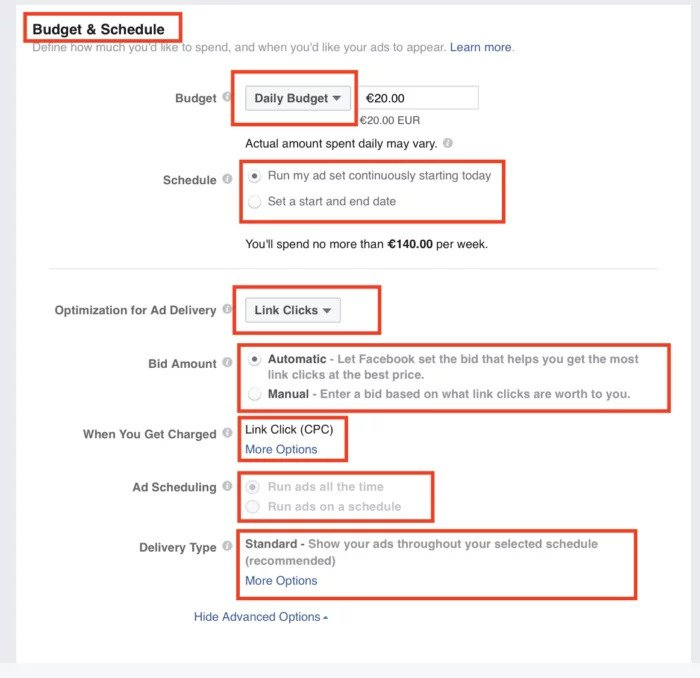
It’s easy to be skeptical when Facebook is suggesting how much you should pay them for each click, but it’s actually very handy. These platforms face huge competition, so they know if they’re not delivering for you, then you will go somewhere else.
This leads to effective ad delivery optimization tools, and they’re especially useful if you’re taking your first steps with Facebook advertising.
8. Create a Facebook Business Page
If you don’t already have a business page, you must create one. This will allow you to benefit from all the ad types Facebook offers.
Go to the create page site and enter your page name, category, and description.
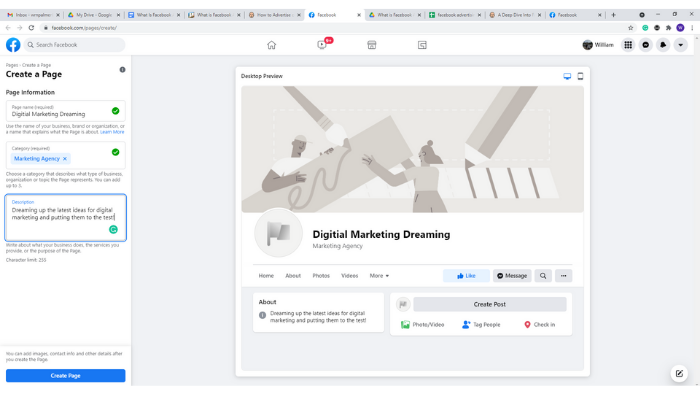
Type some keywords into the category bar, and you’ll get some handy options. Once you’ve entered all your information, then click “Create Page.”
Next, you’ll be prompted to add your profile and cover photo before saving. Once you do this, your page is up and running, and you can start to fill it out by following the simple setup steps.
You’ll see a list of different tasks you can complete, and one that’s particularly worthwhile doing is creating your call to action. This is what will link people to your website, so make sure you choose something that inspires action (for me, “Sign Up” makes the most sense).
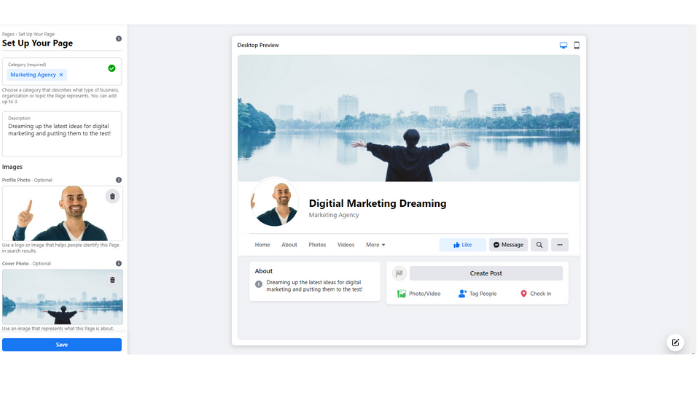
That’s it! You’re all set and ready to go and start running Facebook ads!
9. A/B Test Your Ads
I want to let you in on a little secret. I have no idea what ad will perform best at this point.
Nobody does! It’s impossible. This means the only way to still create a profitable ad campaign is to test a few different options and see which one works.
To do this, we’re going to take an existing ad, but give it a few minor tweaks to run a split test. The ads will mostly be the same, so there’s not even a ton of work involved and you can get a split test up and running within minutes.
Go to your Ad Manager main table, then click on the box of the ad or campaign you want to duplicate and look for the “duplicate” button next to “edit.” Then select “New Split Test Category” and select the number of copies. Do two so you can try a few versions.
Click “Duplicate,” and you’ll be taken to a new ad screen.
As you make changes, be careful. You should actually just change one thing for each copy so you know which changes make a difference to the success of your ad. The only way for you to determine what works and what doesn’t, is by changing one single element, from ad to ad.
Why?
Imagine that you change both the copy and the image for the second ad. Then, you change these two things again and create a third ad. How will you know what made ad B better than ad A and, eventually, ad C better than B?
Was it the new image? The updated headline? The CTA, maybe?
The only way to get absolute certainty of where your results come from is by changing one thing at a time.
There’s another element to split testing too. Facebook ads will suffer from ad fatigue at some point. That means the performance of your ad will start to decline after a few days or weeks.
At first, you’ll be startled. You won’t know what’s happening, or why this “winning” ad is collapsing all of a sudden.
Constantly split testing ads like this will help you avoid that fate. It’ll keep things “fresh” so that audiences won’t get sick of seeing the same ad every single time they log in to Facebook. The best part is that you don’t need to make big changes to avoid ad fatigue. Just little tweaks here and there.
You might be able to take the same exact ad but simply change the background color, flip the layout, or test a new headline.
The point isn’t to completely ditch what works. Finding a successful ad is tough. You’ve got to stick with it and just test little variations to make sure performance won’t drop off a cliff.
Facebook Advertising Frequently Asked Questions
Facebook Advertising: Conclusion
Despite the learning curve, Facebook advertising can be a great marketing channel for the right business. The most important points to remember are: target specific interests, use eye-catching images, give users a low-friction conversion, and track everything.
By following these tips, you will be able to grab people’s attention on a crowded platform and use your Facebook advertising to encourage people to take action.
After a week or two of learning what works for your business, you’ll be able to generate a steady source of Facebook conversions.
What are your best Facebook advertising tips?
